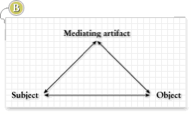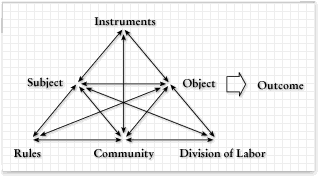Dear All,
...Ruqaiya ponders "purposes and goals" in human activity within an
activity theoretic framework "over-time" in educational performance...
I'm using *one-ish* of the schools of activity theory in my study of
peer collaboration in an EFL classroom during a section of a language
learning program (I haven't had time to read the paper that José David
sent, but will this weekend - it looks like a very interesting study).
I have cc'd and pasted below a section from the proposal for my study
which reflects my understanding at that time of how activity theory may
provide some insights into the intentions and agency of the learners
mentioned above. Right now, I am using Halliday's theory of exchange
structure, thankfully taken up and expanded upon for discourse analysts
by Jim Martin (and see also Eggins and Slade) which allows for a pretty
finely grained analysis of the sequencing of talk from the view of
function of speech as well as mood (see Halliday paper for
elaboration).
The model of activity theory informing this proposal is based upon
Leont’ev’s (1981) expansion of Vygotsky’s (1978) original theory of
mediated mind, whereby a human individual never reacts directly (or
merely with inborn reflects) to the environment. The relationship
between a human agent and the objects of the environment is mediated by
cultural means - tools and signs. This is often represented by a
triangular model, as in Figure 1 below. Engestrom (1987) expanded this
model to include mediation by other human beings, as well as mediation
by social relations, integrating these mediational means into the model
by distinguishing between collective activity and individual action –
or levels of activity. This expanded model of the structure of human
activity is represented by Engestrom (1981) in Figure 2, below.
[Original triangles here]

Figure 1: Vygotsky’s model of mediated action (Cole, 1996)

Figure 2: The structure of a human activity system (Engestrom, 1981, p.
78)
Importantly for Leont’ev, collective activity is representative of an
object-related motive; individual (or sometimes group) action is
representative of a conscious goal; and automatic operations are
representative of the conditions of the action and the tools available.
This tri-stratal model of activity allows for deeper understandings of
an individual’s actions while learning in a group setting. The top
strata of Activity is driven by the object of the activity, and
involves either an individual or collective subject. The next level of
Actions is driven by conscious goal-oriented behaviour, while the final
level, Operations – which are often unconscious behaviours - are driven
by the conditions within which the activity is situated. There is often
a movement from ‘mechanical’ operations to conscious actions when some
form of complication arises, such as a linguistic problem or an
interpersonal/intersubjective breakdown.
This complex theory of the structure of groups of humans working
together to achieve a joint outcome provides some helpful insights for
research into small groups of language learners during learning
activity. A learning task is handed over to a small group of learners
in a learning activity system, which subsequently negotiate a group
object (or objective) for the activity. During the activity,
individuals (subjects) will perform actions that may or may not be
clearly related to the object of the whole activity, but which are
driven by a conscious goal that emerges during the activity. The
instruments of the activity system – the mediating artifacts, largely
language – play a role in the achievement or otherwise of the outcomes
of the activity, as do the rules, which regulate the actions and
interactions during the activity. The joint negotiation of the division
of labour during the activity also impacts on the eventual outcomes, as
do the divisions of power and status of each of the community of
learners, as perceived and possibly co-constructed by the group of
learners. To see how the language learning activity system as the unit
of analysis might look mapped out on Engestrom's triangular model,
click here.
While I have moved on in some senses from this initial point in my
study, particularly in terms of strengthening the focus on Leont'ev's
tri-stratal model of activity, I wonder now about Ruqaiya's and Eric's
problem with analysing social acts over time - does the Leont'ev model
offer some affordances vis-a-vis this problem?
Phil
I have attached this entire message in pdf form in case your machines
are not wholly macintosh friendly
_______________________________________________
xmca mailing list
xmca@weber.ucsd.edu
http://dss.ucsd.edu/mailman/listinfo/xmca
This archive was generated by hypermail 2b29 : Fri Jul 01 2005 - 01:00:08 PDT